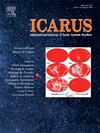Geological analysis of the dome field in western Utopia Planitia, on Mars
IF 3
2区 物理与天体物理
Q2 ASTRONOMY & ASTROPHYSICS
引用次数: 0
Abstract
Hundreds of domes are scattered over a plain composed of different geological units in the western margin of Utopia Planitia, near the northern martian dichotomy. These structures have traditionally been considered of igneous origin. In this work, we utilized recent data to study the geomorphological and compositional properties of this dome field. We found that the domes originated from an intrusive-to-extrusive system, since they range from cryptodomes to volcanic domes. Each dome appears to represent a single magmatic event, indicating they formed in a monogenetic regime. Two main groups of domes were identified according to their shapes and stratigraphic relationships with the floor units, which represent two different stages of igneous activity. It was established from a linear analysis that the domes are preferentially aligned following a NW-SE trend, which is consistent with the regional faults and fractures. The domes field in Utopia Planitia was likely created by two monogenetic magmatic events at different ages, which took advantage of the tectonic configuration of the area to be emplaced. Some magmas were able to reach the surface creating extrusive structures, while the majority crystalized near the surface creating intrusive ones. Of the last group, the majority were uncovered by tectonic or erosive processes, while a small number of them remained trapped underground as cryptodomes. This sequence of events would explain the large distribution of the domes, as well as the wide variety of morphologies that we observe today.
火星乌托邦平原西部穹顶场的地质分析
在乌托邦平原的西部边缘,靠近火星北部的两分法,数百个圆顶散布在由不同地质单元组成的平原上。这些构造传统上被认为是火成岩形成的。在这项工作中,我们利用最近的数据研究了该圆顶场的地貌和成分性质。我们发现这些穹窿起源于侵入-挤压系统,因为它们从隐穹窿到火山穹窿不等。每个圆顶似乎代表一个单一的岩浆事件,表明它们形成于单一的制度。根据它们的形状和与底单元的地层关系,确定了两组主要的圆顶,它们代表了两个不同的火成岩活动阶段。线性分析表明,丘顶优先沿北西-东西走向排列,与区域断裂和断裂相一致。Utopia Planitia的穹窿田可能是由两个不同时代的单成因岩浆事件形成的,这些岩浆事件利用了该地区的构造配置。一些岩浆能够到达地表形成挤压构造,而大多数岩浆在地表附近结晶形成侵入构造。在最后一组中,大多数是由构造或侵蚀过程暴露出来的,而少数仍被困在地下作为隐穹状体。这一系列事件可以解释圆顶的广泛分布,以及我们今天观察到的各种各样的形态。
本文章由计算机程序翻译,如有差异,请以英文原文为准。
求助全文
约1分钟内获得全文
求助全文
来源期刊

Icarus
地学天文-天文与天体物理
CiteScore
6.30
自引率
18.80%
发文量
356
审稿时长
2-4 weeks
期刊介绍:
Icarus is devoted to the publication of original contributions in the field of Solar System studies. Manuscripts reporting the results of new research - observational, experimental, or theoretical - concerning the astronomy, geology, meteorology, physics, chemistry, biology, and other scientific aspects of our Solar System or extrasolar systems are welcome. The journal generally does not publish papers devoted exclusively to the Sun, the Earth, celestial mechanics, meteoritics, or astrophysics. Icarus does not publish papers that provide "improved" versions of Bode''s law, or other numerical relations, without a sound physical basis. Icarus does not publish meeting announcements or general notices. Reviews, historical papers, and manuscripts describing spacecraft instrumentation may be considered, but only with prior approval of the editor. An entire issue of the journal is occasionally devoted to a single subject, usually arising from a conference on the same topic. The language of publication is English. American or British usage is accepted, but not a mixture of these.
 求助内容:
求助内容: 应助结果提醒方式:
应助结果提醒方式:


